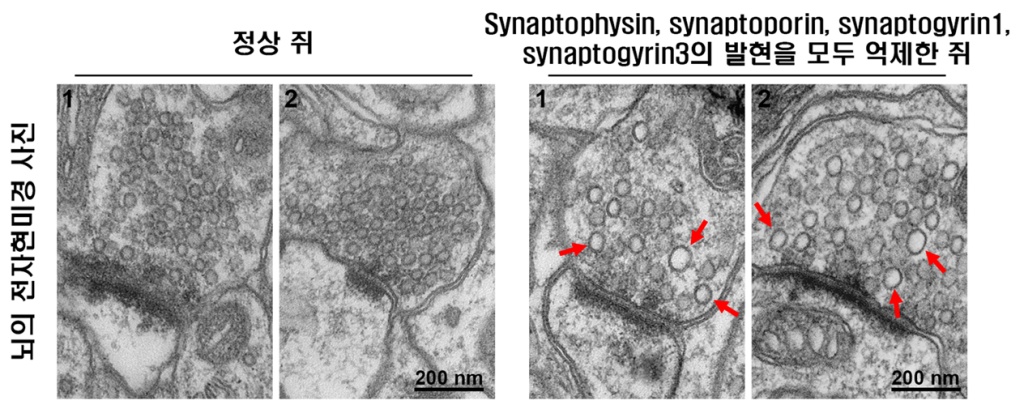Professor Park Dae-hoon's Research Team Discovers Neurotransmitter Vesicles in Brain
- Writer :대외협력팀
- Date :2024.07.15
- Views :155
Professor Park Dae-hoon's Research Team of Medical and Biological Science Discovers a Factor that Controls the Size of Neurotransmitter Vesicles in the Brain.
-The Catholic University of Korea's research team led by Medical and Biological Science professor Park Dae-hoon clarifies the function of synaptophysin in the brain, which was a conundrum in neurobiology
- Three countries' Joint research results from △Department of Medical and Biological Science of CUK, △School of Medicine of Yale University in USA, and △CSIC-UMH in Spain
- Research results published in the Proceedings of the National Academy of Sciences (PNAS), an international academic journal in the field of life sciences and multidisciplinary research

*Photo Description: Actual appearance of the synapses of nerve cells in the brain of a normal mouse (left) and a mouse in which all synaptophysin and other synaptic vesicle-related proteins (synaptoporin, synaptogyrin1, synaptogyrin3) were knocked out. When all four proteins were removed, synaptic vesicles (red arrows) of a much larger size were created compared to the normal mouse.
The Catholic University of Korea (President Won Jong-cheol)'s Medical and Biological Science professor Park Dae-hoon and his research team has discovered for the first time in the world that synaptophysin protein controls the size of synaptic vesicles, which are neurotransmitter sacs in the brain ,through international joint research with school of Medicine of Yale University in USA and CSIC-UMH in Spain.
This study clarified the function of synaptophysin, which has been a difficult problem in the field of neurobiology for 40 years, and is expected to greatly contribute to the development of synaptic vesicle research, which is the most basic for regulating normal brain function. The results of this study, which was conducted through collaboration between Korea, the US, and Spain, were published in the online version of ‘PNAS (Proceedings of the National Academy of Sciences of the United States of America),’ an authoritative international academic journal in the field of life sciences and multidisciplinary fields, on July 10, and were recognized for their excellence.
The role of ‘synaptic vesicles,’ which are small sacs that store neurotransmitters, is very important for smooth communication between neurons in the brain. When stimulated, synaptic vesicles secrete the neurotransmitters they contain outside the cell membrane, causing signal transmission to the next nerve cell. It is known that numerous proteins, including ‘synaptophysin’, that affect stimulus regulation exist on the surface of these synaptic vesicles.
Synaptophysin is a representative protein present in synaptic vesicles, and its expression level is very high among the numerous types of synaptic vesicle proteins. However, until recently, it has not been clearly revealed what function synaptophysin performs in nerve cells. An international joint research team including Professor Park Dae-hoon conducted research based on the neural cell simulation technology using non-neuronal cells published in the international academic journal Nature Communications in 2021 and 2023, and obtained a clue that synaptophysin and other synaptic vesicle-associated proteins (synaptoporin, synaptogyrin1, synaptogyrin3) commonly play an important role in the formation of synaptic vesicles.
As a result of the research, the size of synaptic vesicles was found to increase dramatically in the brains of mice in which all synaptic vesicle-associated proteins, including synaptophysin, were missing, revealing that these proteins are directly involved in regulating the size of synaptic vesicles.
Medical and Biological Science professor Park Dae-hoon of The Catholic University of Korea said, “The results of this study have allowed us to better understand the formation mechanism of synaptic vesicles, which are most fundamentally required for the normal functioning of the brain.” He added, “We expect that we will be able to uncover not only the mechanism of filling the interior of synaptic vesicles with neurotransmitters, but also its relationship with various nervous system dysfunctions.”

